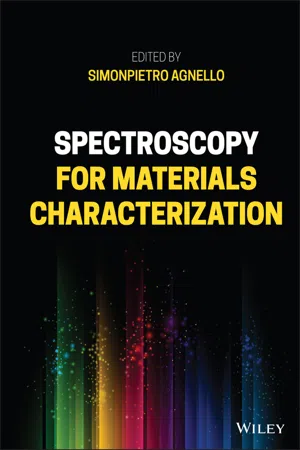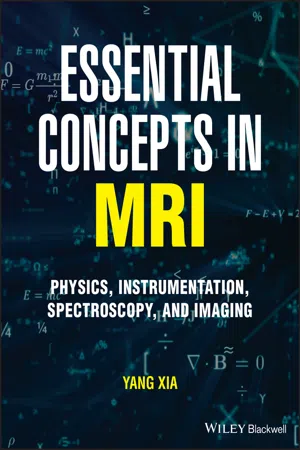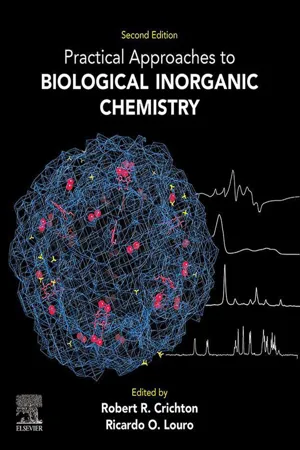Chemistry
Factors Affecting Chemical Shift
Factors affecting chemical shift in NMR spectroscopy include the electronic environment, chemical structure, and neighboring atoms. Electronegativity, hybridization, and molecular geometry can influence the chemical shift of a nucleus. Additionally, the presence of nearby electronegative atoms or functional groups can also impact the chemical shift.
Written by Perlego with AI-assistance
8 Key excerpts on "Factors Affecting Chemical Shift"
Learn about this page
Index pages curate the most relevant extracts from our library of academic textbooks. They’ve been created using an in-house natural language model (NLM), each adding context and meaning to key research topics.
- eBook - ePub
- Simonpietro Agnello, Simonpietro Agnello(Authors)
- 2021(Publication Date)
- Wiley(Publisher)
ref are the resonant frequencies of the sample and the reference, respectively. The total frequency range of the chemical shifts of a certain nucleus depends both on the applied magnetic field and on the isotope to be studied. The NMR spectra are represented with decreasing frequencies toward the right with zero coinciding with the resonance of the reference. If one nucleus is more shielded than another, its signal will be shifted to lower frequencies (or higher fields). The observation of an NMR spectrum of a specific molecule depends precisely on this chemical shielding property.The importance of the chemical shift lies in the fact that it reveals changes in the chemical and physical surroundings of a molecule. The first advantage of the chemical shift is that the nuclei exhibit specific resonances which depend on their chemical nature. In addition to the characteristic frequencies of certain groups in IR or Raman spectroscopy, similar functional groups will have similar chemical shifts.The spins can also interact with each other directly. If this interaction occurs through space, then it is called a direct dipole–dipole interaction. This interaction is important as it provides structural information since the intensity of the dipolar interactions depends on the internuclear distance.Let us consider the general model of an isolated pair of spin ½ nuclei, which we will call μ l and μ 2 , interacting through their own dipoles.The dipole associated with μ l precesses around B 0 at its Larmor frequency, thus generating a static component along the direction of the field and a rotating component in the plane perpendicular to the direction of B 0 . The static component of μ l produces a small static field at the μ 2 dipole site. The intensity of this last local magnetic field B loc depends on the relative positions of the two spins and their orientations with respect to B 0 . If a sample containing this isolated pair of nuclei is subjected to the static magnetic field B 0 , the result will be that each nucleus will experience an effective magnetic field B eff - eBook - ePub
Essential Concepts in MRI
Physics, Instrumentation, Spectroscopy and Imaging
- Yang Xia(Author)
- 2022(Publication Date)
- Wiley-Blackwell(Publisher)
1 ] could be due to structural symmetry, rapid rotation, or simply by coincidence.If another group of nuclei has very different chemical shifts, the letters at the end of the alphabet are commonly used to name them, such as X, Y. (It may also be used as an approximation for nuclei of the same species where the coupling is much less than the chemical shift differences.) When there are more than two well-separated groups of nuclei, a middle letter of the alphabet can be used, for example, AMX implies the existence of three different nuclei with three different magnetic environments. Other nomenclatures of the spin system in NMR spectroscopy also exist [1–3 ].8.2 PEAK SHIFT – THE EFFECT OF CHEMICAL SHIFT
In Chapter 4.2 , the equation for chemical shift was given asf = γ, where σ is the shielding constant and f is the temporal/linear frequency in hertz; and chemical shift is discussed in this book with the assumption of diamagnetic materials. Practically, chemical shift of a resonance is compared to that of a reference, commonly tetramethylsilane (TMS) in 1 H and 13 C spectroscopy. In a typical plot of an NMR spectrum, the horizontal axis is the chemical shift in ppm and the vertical axis is the signal amplitude. The chemical shift of the nucleus is commonly quoted in the δ scale, given byB 0( 1 − σ ) / 2 π(8.1)where the 106 factor converts the chemical shift from the frequency ratio to ppm [cf. Eq. (4.10)].In the early days of NMR experiments, the electric current was slowly increased in the coil of an electromagnet to increase the external magnetic fieldB 0[cf. Eq. (5.1)]. If a resonance occurred in the sample, an absorption peak would show up on the cathode-ray screen of an analog oscilloscope, which was recorded on paper by a chart recorder. If there was no resonance after a reasonable amount of time, one increased the electric current to produce a higher field. The left-hand side of the recording paper therefore represented the effect of the lower magnetic field and was called “downfield.” The right-hand side of the recording paper contained the result of the higher magnetic field and was called “upfield.” A larger shielding constant, σ , requires a higher field to reach the resonance; so a peak with a large σ would appear on the right side of the recording paper. Sinceω = γB 0( 1 − σ ) - eBook - ePub
Essentials of Chemical Biology
Structure and Dynamics of Biological Macromolecules
- Andrew D. Miller, Julian A. Tanner(Authors)
- 2013(Publication Date)
- Wiley(Publisher)
spin–spin coupling. These topics will be covered very briefly in turn.5.2.4.1 Chemical shift
Chemical shift may be thought of as the manner in which the resonance frequencies, ν L , of nuclei that are part of molecular structures vary in a systematic and reproducible way in response to local chemical environment. According to Equation (5.9) , changes in external magnetic field strength experienced by a given nucleus must have a direct affect on the energy difference between nuclear spin states leading to a proportionate change in resonance frequency, ν L . Chemical shift arises because the strength of the effective external magnetic field experienced by any nucleus in a molecular structure appears to vary in response to local movements in neighbouring electron density. In other words, local electronic effects have direct and reproducible effects on ν L values. Electronic effects are both shielding and deshielding in character. Shielding effects are generated by the tendency of an external magnetic field to induce electron density to ‘circulate’ in such a way as to create a local magnetic field in opposition to the applied field. The effective external magnetic field experienced by any such nucleus is then modulated according to(5.10)where B eff, z is the effective field experienced by the nucleus and shielding is characterised by the shielding parameter, σ N , also known as the chemical shift tensor. Deshielding arises out of hetero-atom σ -bond inductive effects and π -bond ring current effects. The former effect reduces local electron density around a given nucleus, hence increasing the effective field and hence ν L . The latter effect creates local magnetic fields that cooperate with the applied field to increase the effective external magnetic field experienced by nuclei and hence their ν L values (Figure 5.6 ). Together, shielding and deshielding effects are primarily responsible for ensuring that ν L values vary as a direct consequence of local chemical environment and are therefore a direct indication of the nature of this chemical environment. In order to ensure that variation in ν L values as a function of local chemical environment is standardised between NMR experiments and NMR spectrometers, the δ chemical shift scale was introduced. This scale is defined by Equation (5.11) - eBook - ePub
Mutagenic Impurities
Strategies for Identification and Control
- Andrew Teasdale, Andrew Teasdale(Authors)
- 2022(Publication Date)
- Wiley(Publisher)
19 F NMR spectrum.There is also a dependence on the NMR solvent used. With modern spectrometers, any solvent can be used for NMR and there is no longer the requirement for the NMR solvent to be deuterated, although this can still be beneficial. It is conceivable that even if no resolution between two atoms is seen in one solvent the choice of a different solvent may achieve sufficient resolution.The chemical shift of atoms near a possible protonation site will also change depending on the protonation state. This effect can be utilized to achieve resolution between nuclei that may not be resolved originally. For example, in compounds (1) and (2) the two protons HA and HB have approximately the same chemical shift in d6 ‐DMSO (dimethyl sulfoxide) and hence are not resolved from each other. The addition of a base deprotonates the NH2 group, causing a change in the chemical shift of HB . HB is now resolved from HA .13.3.3 Scalar Coupling
The chemical shift of a given nucleus is not only affected by the local chemical environment, but the exact frequency also depends on the spin‐state of other nearby nuclei. For example, if you consider two nearby protons A and B as in Figure 13.2 , the frequency of proton A is different depending on whether proton B is in spin‐state α or β . The result of this is that the signal from proton A appears as a doublet (the signal is split into two signals of approximately equal intensity). The effect, called scalar coupling, continues for all nearby protons, often resulting in a complex multiplet structure.Scalar coupling is extremely useful for structure elucidation, because it contains a wealth of molecular connectivity information. However, the coupling can cause a problem for trace analysis as it not only reduces sensitivity but can also result in less resolution between signals as shown in Figure 13.3 - Gauri Misra(Author)
- 2019(Publication Date)
- Academic Press(Publisher)
50] .The sensitivity refers to the distinction between the background noise and a real resonance signal. Often these two characteristics may be associated because when there is a loss of resolution (peak broadening) there is associated decrease in sensitivity (peak height).In NMR measurements, the electron shielding is the primary effect observable that happens by the movement of the electrons in the orbit of nuclei. In this way, the value of the field effectively applied to a given nucleus will be different of B0 . The electron shielding shifts the position line in the spectrum, often to the right side, strengthening the effect. The high field of the spectrum, the values of the chemical shift are smaller, usually <3 ppm, when considering hydrogen frequency. At the same time, the value of frequency will also be lower. On the other hand, when the electron density is lower, the strength of the field B 0 will be more effective. In this case, the nucleus is deshielded. Under such conditions, it is observed that higher values of the resonance frequency, higher values of chemical shifts in the low field region are usually located to the left side of the spectrum [51] .The inductive effect may be the simplest way to understand the mechanism of this electron density displacement [45] . The stable state of the partial polarization of the bond between any two atoms represents this change in the local electron density. The force of the inductive effect is a factor of the distance between the two nuclei covalently bound and the difference in the value of electronegativity between them. It is also important to note that the electron density is also related to the presence of π resonance (double and triple bonds) and the bond geometry. In all cases, the practical result of this phenomenon is the asymmetric distribution of charges in the polarized bond. When the electronegative atom is the primary source of asymmetry in the bond (electron attractor), it is termed as negative induction [52]- eBook - ePub
Polymer Characterization
Physical Techniques, 2nd Edition
- Dan Campbell, Richard A. Pethrick, Jim R. White(Authors)
- 2017(Publication Date)
- CRC Press(Publisher)
In the absence of other interactions, for a given applied frequency and nuclear spin type, NMR resonance would only be observed at a single value of the field strength and this would result in a single absorption peak. If this were the case, NMR spectroscopy would be very limited as an analytical technique. In fact the field experienced by the nucleus is modified due to magnetic shielding by electrons orbiting the nucleus. In effect, induced electric currents produce magnetic fields which oppose the applied magnetic field. The higher the electron density around the nucleus and the higher the applied field, the greater the extent of shielding.The effective field experienced by the nucleus is expressed byB eff=B 0( 1 − σ )( 6.14 )where σ is termed the screening constant. The magnitude of σ depends on the particular chemical environment, since it is this which determines the electron density around the nucleus. As a consequence, the effect is referred to as the chemical shift.The difference in energy between the levels for nuclei for which I = 1/2 is now given byΔ E =g Nβ NB 0( 1 − σ )( 6.15 )so that the positions of resonance lines can be used to identify particular chemical environments, e.g. different hydrogen atoms within an organic molecule. In order to do so it is necessary to have some practical measure of the extent of shielding. We have already seen that the chemical shift is dependent on the applied field strength. However, NMR spectrometers operate at different field strengths so it is clearly desirable to be able to express the chemical shift in a form that is field independent. This can be done quite easily by referring the chemical shifts to a standard substance. The accepted standard most usually employed for 1 H resonance is tetramethylsilane (TMS) which contains 12 equivalent protons and so gives rise to a single intense absorption line for 1 H resonances (and for 13 C and 29 Si). For convenience the TMS signal can be recorded at the same time as the sample under examination. The procedure used for comparison leads to the definition of a dimensionless parameter termed the chemical shift (δ ) such that δ = (σ TMS – σ ) × 106 - Robert R. Crichton, Ricardo O. Louro(Authors)
- 2019(Publication Date)
- Elsevier(Publisher)
- • If the transverse relaxation is too fast the signals will be too broad to be detected. Therefore very large molecules will be difficult to study.
- • If there were no transverse relaxation the signal would be very sharp, and the linewidth would arise only from the Uncertainty principle.
A spectrum such as that in Fig. 5.9 , with a single signal is not of much use. Fortunately, nuclei of the same nature can have slightly different Larmor frequencies depending on the surrounding environment, therefore increasing the information content in a NMR experiment.The chemical shift
Atomic nuclei are immersed in atomic or molecular electron clouds. Electrons, being charged particles that are not static, are sensitive to the presence of the magnetic field of the spectrometer and generate a very weak local magnetic field. Therefore the nuclei sense an effective field that is different from the static field due to the influence of the surrounding electronic environment—the nuclear shielding (σ ). Typically, the distribution of electrons around the nuclei is not spherical. The nuclear shielding tensor is anisotropic and thus is defined with respect to each direction of the axes system (the three principal components) giving rise to the phenomenon of chemical shift anisotropy . Fortunately, in solution, this effect averages out due to the fast and isotropic reorientation of the molecules, and thus a single value for the nuclear shielding can be used. Subsequently, the Larmor frequency can be expressed as:ω(5.14)= −γ ( 1−σ )B 0,(5.14)In these conditions, a different chemical environment gives rise to a characteristic nuclear shielding. Therefore there are very typical spectral regions where the signals of nuclei with a particular chemical nature can be found.As seen from the Larmor equation, the resonance frequency is dependent on the static field strength, and therefore the frequency difference between two signals increases with field strength. On the other hand, the chemical shift (δ- eBook - ePub
Characterization of Solid Materials and Heterogeneous Catalysts
From Structure to Surface Reactivity
- Michel Che, Jacques C. Vedrine, Michel Che, Jacques C. Vedrine(Authors)
- 2012(Publication Date)
- Wiley-VCH(Publisher)
It follows that the resulting signal will be very broad with the source of this broadening again being dependent on the term (3cos 2 θ – 1). As with the dipolar interaction, anisotropic chemical shift effects are not present in liquids or gases. In contrast to the dipolar interaction where rapid isotropic motion causes the disappearance of the interaction, in the case of the chemical shift interaction, isotropic rotation leaves a residual interaction which is identified as the “chemical shift” of a species recorded in an NMR spectrum. Thus, not only is NMR a nuclear-specific probe as a result of the Zeeman effect, but also the subtle modifications to the energy splitting resulting from the chemical shift interaction make NMR sensitive to particular chemical groups and it therefore becomes molecule and molecular group specific. In order that chemical shift values can be compared between acquisitions at different field strengths, chemical shift values, δ, are quoted relative to a standard, where δ is defined as (8.4) at constant B 0, where ω = 2 πν, and has units of parts per million (ppm). 8.2.1.4 Quadrupolar Interaction The quadrupolar interaction arises from the interaction of the nuclear quadrupole moment (associated with spins of I > ½) with the non-spherically symmetrical field gradient around the nucleus. The magnitude of the interaction is such that for most nuclei it completely dominates the spectrum; this is even the case for deuterium,, which has the smallest quadrupole moment. The quadrupolar interaction is sensitive to the presence of molecular motion and NMR has been used by a number of workers to investigate the dynamics of molecules at surfaces. Under conditions of molecular reorientation, the precise lineshape depends on the nature of the motion and its correlation time







